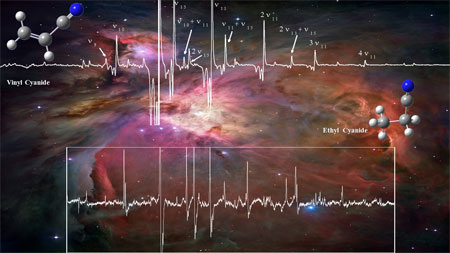
The chemistry of the interstellar medium is uncertain so research is being undertaken to improve our molecular understanding of the universe.
Through the research projects Consolider and Nanocosmos, GEM is contributing to the identification of metal bearing compounds and new species in the interstellar medium. The precise detection of these molecules is crucial for the interpretation of the spectra recorded by the new astrophysical observatories as ALMA and Herschel.
Ref. Consolider: http://www.icmm.csic.es/consolider-ingenio-astromol/
Ref. Nanocosmos: http://www.icmm.csic.es/nanocosmos
Metal-bearing compounds
Featured work
Laboratory and astronomical discovery of hydromagnesium isocyanide,
ApJ, 2013, 775:133(4pp)
We report on the detection of hydromagnesium isocyanide, HMgNC, in the laboratory and in the carbon rich evolved star IRC+10216. The J=1-0 and J=2-1 lines were observed in our microwave laboratory equipment in Valladolid with a spectral accuracy of 3\,KHz. The hyperfine structure produced by the Nitrogen atom was resolved for both transitions. The derived rotational constants from the laboratory data are B0=5481.4333(6)\,MHz,D0=2.90(8)\,KHz, and eQq(N)=-2.200(2)\,MHz.
The predicted frequencies for the rotational transitions of HMgNC in the millimeter domain have an accuracy of 0.2-0.7\,MHz. Four rotational lines of this species, J=8-7, J=10-9, J=12-11 and J=13-12, have been detected towards IRC+10216. The differences between observed and calculated frequencies are <0.5\,MHz. The rotational constants derived from space frequencies are B0=5481.49(3)\,MHz and D0=3.2(1)\,KHz, i.e., identical to the laboratory ones. A merged fit to the laboratory and space frequencies provides B0=5481.4336(4)\,MHz and D0=2.94(5)\,KHz.
We have derived a column density for HMgNC of (6±2)×1011\,cm−2. From the observed line profiles the molecule has to be produced in the layer where other metal-isocyanides have been already found in this source. The abundance ratio between MgNC and its hydrogenated variety, HMgNC, is≃20.
Last contributions
J. Chem. Phys., 2014, 141, 104305
J. Mol. Spectrosc., 2012 278, 31-34
New molecules in the ISM
Featured work
Spectroscopic Characterization and Detection of Ethyl Mercaptan in Orion,
ApJ, 2014, 784 L7. doi:10.1088/2041-8205/784/1/L7
New laboratory data of ethyl mercaptan, CH3CH2SH, in the millimeter- and submillimeter-wave domains (up to 880 GHz) provided very precise values of the spectroscopic constants that allowed the detection of gauche-CH3CH2SH toward Orion KL. This identification is supported by 77 unblended or slightly blended lines plus no missing transitions in the range 80-280 GHz. A detection of methyl mercaptan, CH3SH, in the spectral survey of Orion KL is reported as well. Our column density results indicate that methyl mercaptan is ![]() 5 times more abundant than ethyl mercaptan in the hot core of Orion KL
5 times more abundant than ethyl mercaptan in the hot core of Orion KL
Last contributions
*High-resolution rotational spectrum, Dunham coefficients, and potential energy function of NaCl
ApJ, 2016, 825:150 (10pp)
*The millimeter wave spectrum of methyl cyanate: laboratory study and astronomical search in space
A&A, 2016, 591, A75
*Comprehensive analysis of prebiotic propenal up to 660 GHz
ApJS 2015, 218:30 (7pp)
*Laboratory characterization and astrophysical detection of vibrationally excited states of vinyl cyanide in Orion-KL,
A&A, 2014, 572, A44
*The millimeter and submillimeter wave spectrum of cis-methyl vinyl ether,
J. Mol. Spectrosc., 2014, 306, 11–18
*Laboratory Characterization and Astrophysical Detection of Vibrationally Excited States of Ethyl Cyanide,
ApJ, 2013, 768:81 (13pp)


